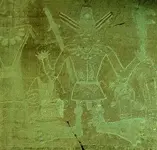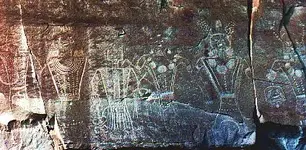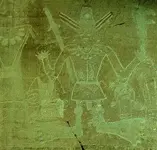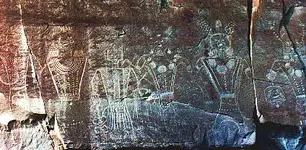Re: CPTBIL's mention of Aztec pictographs in SE Arizona
Roy,
This is a bit long but, IMHO, it is worth reading:
From Chapter 10 of, "Man before Adam: The Story of Man in Search of His Origins." by Robert Silverberg, we find this:
[The attentive reader, by this point, may be troubled about the geography of fossil man. We have talked of ancient men from Germany and France, from Java and China, from England, from South Africa, from East Africa, from Algeria. We have said nothing at all, though, of fossil discoveries made in North or South America. Not a word about an American Pithecanthropus, an American Neanderthal, an American species of Australopithecus.
There is a very sound reason for this apparent neglect. Man came late to the Western Hemisphere. He was Homo sapiens when he got here. His arrival dates back no more than 30,000 years, so far as we know today, human evolution happened elsewhere; man in the Americas was strictly an imported product.
The evidence for this is negative, but impressive in its negativeness. No one has ever found a fossil human of a pre-sapiens hominid in the Western Hemisphere. Moreover, no fossil apes have been found, either. No higher primates at all inhabit or ever inhabited the Americas, so far as we know, except for the tailed monkeys of South America and that recent immigrant, Homo sapiens.
There are some who have thought otherwise. In 1866, for example, a fossilized human skull with fairly prominent brow ridges was found at a depth of 130 feet in a gold mine in California. The place was Calaveras County, which Mark Twain immortalized with his story of the Jumping Frog. The Calaveras skull was found under four levels of lava and three of gold-bearing gravels, and at the very least seemed to date from Tertiary times. Then as now, Pliocene man, dating back three or four million years, was a newsworthy discovery.
J. D. Whitney, a leading geologist of the day, inspected the Calaveras skull and the mine where it had been found, and concluded, in a report to the California Academy of Natural Sciences, that the skull was genuinely Tertiary. Another Whitney report fourteen years later, in 1880, expressed the same opinion. The Calaveras skull was widely deplored because it seemed to disprove by its great age the teachings of the Bible and to back the ideas of that subversive Englishman, Charles Darwin.
Alas for J. D. Whitney and his reputation, later research showed the Calaveras skull to be a fraud. The anthropologist Ales Hrdliccka checked into the story at the beginning of this century, and found that the miners had dug the skull out of recent strata and had buried it in the Pliocene levels as a prank. Hrdliccka produced other skulls from California caves which looked just as ancient as the Calaveras skull, but which dated back only two or three thousand years. So much for Tertiary man in California!
About the same time as Hrdlicka was debunking the Calaveras skull, an Argentinian paleontologist named Fiorino Ameghino was claiming to have found Tertiary primates on the pampas-early Tertiary at that. Ameghino came forth with the bones of various creatures that he gave such names as Homunculus patagonicus, Anthropops perfectus, and so on. They were, he said, ancestors of man and the higher apes, and he worked out elaborate family trees to prove it. Wiser men showed that Ameghino's fossils were those of fairly recent monkeys, and that his theories were pathetic figments of a deluded imagination.
In 1922, another fossil anthropoid came out of Nebraska. A tooth discovered in Pliocene formations there was said to belong to a creature called Hesperopithecus, which combined aspects of Pithecanthropus, Homo sapiens, and the chimpanzee. Five years later came an embarrassed correction: the celebrated molar actually was that of Prosthenops, an extinct pig! Other fossil finds in the late nineteenth and early twentieth centuries turned out similarly to be false alarms. Not only were pre-sapiens human fossils totally absent in the Americas, but Homo sapiens himself did not seem to go back more than a few thousand years at most. It was generally agreed that man had come to the New World across the Bering Strait, which separates Alaska from Siberia and is only fifty-six miles wide. The ancestors of the Indians might have crossed the strait in boats, or even on foot, crossing on winter ice, perhaps.
One school of thought held that man had come here ten or fifteen thousand years ago, toward the end of the Fourth Ice Age. Because glaciers had drawn up much of the world's water supply then, sea level was much lower, and shallow Bering Strait was probably completely dry. Man could have walked across from Siberia.
But opponents of this idea, led by Ales Hrdlicka, said no. Man in the Americas was extremely recent, Hrdlicka insisted. Beginning in 1907 with the publication of his Skeletal Remains Suggesting or Attributed to Early Man in North America, the brilliant, fiery, dogmatic Hrdlicka set himself up as the enemy of any theory of man's antiquity here. First he demolished Ameghino and the Calaveras skull. Then he went after each successive find of so-called primitive men in the Americas. Hrdlicka's papers bristled with phrases like "not in the least primitive," "essentially modern," "not to be distinguished from the modern Indian." From his office in the Smithsonian he insisted that no proof had ever been offered that man had reached the Americas much before the time of Christ.
Hrdlicka's work was valuable, because it cleared away a great deal of error, confusion, and downright fraud. But as he grew older his opinions hardened into prejudices. His attacks grew more emotional. And other scientists began to wonder whether the peppery dean of American physical anthropology was completely correct. By the 1920's, everyone agreed with Hrdlicka that man had come to the Americas in the form of Homo sapiens. But had the first Indian arrived only three or four thousand years ago, as Hrdlicka said?]
This book is well worth reading for anyone interested in the history of man.
Take care,
Joe












